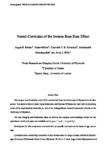Neural correlates of the inverse base-rate effect
| dc.contributor.author | Inkster, A | |
| dc.contributor.author | Milton, F | |
| dc.contributor.author | Edmunds, CER | |
| dc.contributor.author | Benattayallah, A | |
| dc.contributor.author | Wills, Andy | |
| dc.date.accessioned | 2021-11-16T09:39:47Z | |
| dc.date.issued | 2021-11-26 | |
| dc.identifier.issn | 1065-9471 | |
| dc.identifier.issn | 1097-0193 | |
| dc.identifier.uri | http://hdl.handle.net/10026.1/18369 | |
| dc.description.abstract |
<jats:title>Abstract</jats:title><jats:p>The inverse base rate effect (IBRE) is a nonrational behavioral phenomenon in predictive learning. Canonically, participants learn that the AB stimulus compound leads to one outcome and that AC leads to another outcome, with AB being presented three times as often as AC. When subsequently presented with BC, the outcome associated with AC is preferentially selected, in opposition to the underlying base rates of the outcomes. The current leading explanation is based on error‐driven learning. A key component of this account is prediction error, a concept previously linked to a number of brain areas including the anterior cingulate, the striatum, and the dorsolateral prefrontal cortex. The present work is the first fMRI study to directly examine the IBRE. Activations were noted in brain areas linked to prediction error, including the caudate body, the anterior cingulate, the ventromedial prefrontal cortex, and the right dorsolateral prefrontal cortex. Analyzing the difference in activations for singular key stimuli (B and C), as well as frequency matched controls, supports the predictions made by the error‐driven learning account.</jats:p> | |
| dc.format.extent | 1370-1380 | |
| dc.format.medium | Print-Electronic | |
| dc.language | en | |
| dc.language.iso | en | |
| dc.publisher | Wiley Open Access | |
| dc.subject | cognitive neuroscience | |
| dc.subject | fMRI | |
| dc.subject | human learning | |
| dc.subject | inverse base rate effect | |
| dc.subject | prediction error | |
| dc.title | Neural correlates of the inverse base-rate effect | |
| dc.type | journal-article | |
| dc.type | Journal Article | |
| dc.type | Research Support, Non-U.S. Gov't | |
| plymouth.author-url | https://www.webofscience.com/api/gateway?GWVersion=2&SrcApp=PARTNER_APP&SrcAuth=LinksAMR&KeyUT=WOS:000722656200001&DestLinkType=FullRecord&DestApp=ALL_WOS&UsrCustomerID=11bb513d99f797142bcfeffcc58ea008 | |
| plymouth.issue | 4 | |
| plymouth.volume | 43 | |
| plymouth.publication-status | Published | |
| plymouth.journal | Human Brain Mapping | |
| dc.identifier.doi | 10.1002/hbm.25729 | |
| plymouth.organisational-group | /Plymouth | |
| plymouth.organisational-group | /Plymouth/Admin Group - REF | |
| plymouth.organisational-group | /Plymouth/Admin Group - REF/REF Admin Group - FoH | |
| plymouth.organisational-group | /Plymouth/Faculty of Health | |
| plymouth.organisational-group | /Plymouth/Faculty of Health/School of Psychology | |
| plymouth.organisational-group | /Plymouth/REF 2021 Researchers by UoA | |
| plymouth.organisational-group | /Plymouth/REF 2021 Researchers by UoA/UoA04 Psychology, Psychiatry and Neuroscience | |
| plymouth.organisational-group | /Plymouth/Research Groups | |
| plymouth.organisational-group | /Plymouth/Research Groups/Institute of Health and Community | |
| plymouth.organisational-group | /Plymouth/Users by role | |
| plymouth.organisational-group | /Plymouth/Users by role/Academics | |
| dc.publisher.place | United States | |
| dcterms.dateAccepted | 2021-11-15 | |
| dc.rights.embargodate | 2021-12-14 | |
| dc.identifier.eissn | 1097-0193 | |
| dc.rights.embargoperiod | Not known | |
| rioxxterms.versionofrecord | 10.1002/hbm.25729 | |
| rioxxterms.licenseref.uri | http://www.rioxx.net/licenses/all-rights-reserved | |
| rioxxterms.licenseref.startdate | 2021-11-26 | |
| rioxxterms.type | Journal Article/Review |


